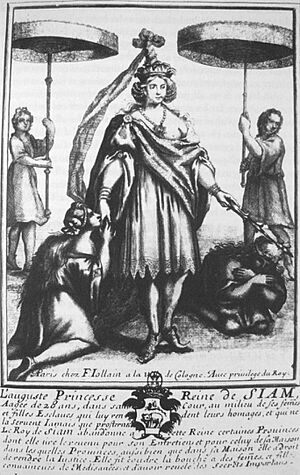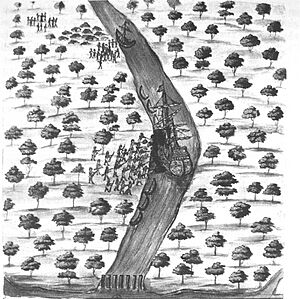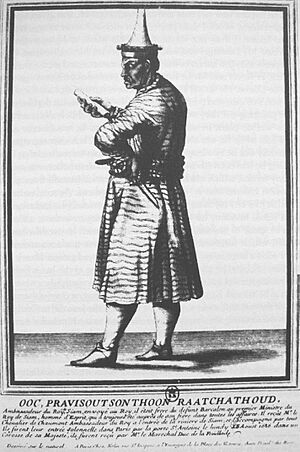Siamese revolution of 1688 facts for kids
Quick facts for kids Siamese Revolution |
|||||||
|---|---|---|---|---|---|---|---|
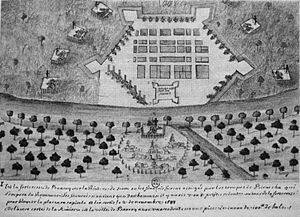 The siege of the French fortress in Bangkok by the Siamese revolutionary forces of Phetracha in 1688. |
|||||||
|
|||||||
| Belligerents | |||||||
|
|
|||||||
| Commanders and leaders | |||||||
| Phetracha Luang Sorasak Krommaluang Yothathep |
Constantine Phaulkon Chevalier de Beauregard (POW) |
||||||
The Siamese Revolution of 1688 was a big event in the Ayutthaya Kingdom (which is now Thailand). It was a popular uprising that led to a new king taking power. The old king, Narai, had strong ties with France.
Phetracha, who was one of King Narai's trusted military leaders, took advantage when Narai became very sick. Phetracha removed Narai's chosen heir and also got rid of Narai's important foreign minister, Constantine Phaulkon. After this, Phetracha married Narai's daughter and became the new king. He then worked to remove all French influence and soldiers from Siam.
One of the most important battles was the Siege of Bangkok in 1688. During this siege, tens of thousands of Siamese soldiers surrounded a French fortress in the city for four months. After the revolution, Siam mostly stopped its connections with Western countries. The only exception was the Dutch East India Company. This changed much later, in the 1800s.
Contents
King Narai's Foreign Connections
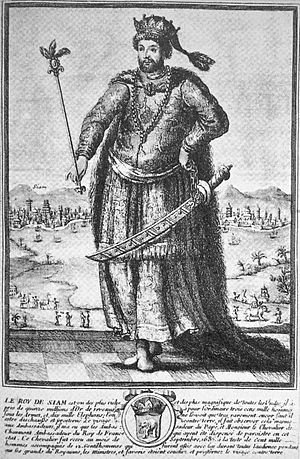
King Narai's time as ruler saw many new connections with Western countries. These included France, England, and the Vatican. Siam also sent and received visitors from Persia, India, and China.
A special thing about Narai's rule was how much influence foreigners had in his royal court. The most famous example was Constantine Phaulkon. He was a Greek adventurer who became very powerful, like a Prime Minister today.
King Narai especially wanted to make friends with the French. He hoped this would balance the power of the Portuguese and Dutch in his kingdom. Phaulkon, his Greek advisor, also suggested this. Many groups of ambassadors traveled between France and Siam.
Growing Unhappiness with Foreigners
France wanted King Narai to become Catholic. They also wanted to set up their own soldiers in Siam. King Narai allowed them to build forts with French soldiers in Mergui and Bangkok. This was to help with trade, reduce Dutch power, and fight pirates.
However, having French soldiers in Siam made many local people unhappy. By 1688, strong feelings against foreigners, especially the French and Phaulkon, were at their highest point.
- Siamese courtiers (people who worked for the king) disliked how much power Phaulkon, the Greek advisor, had. They also didn't like his European way of life.
- Buddhist religious leaders were worried about the growing presence of French Jesuits (Catholic priests).
- Other foreigners who had lived in Ayutthaya before the French, like the Protestant Dutch and English, and Muslim Persians, also didn't like the French gaining more power in business and politics.
- Even other Catholic groups, like the Portuguese, felt that the French presence was unfair. It reminded them that Portugal's power was decreasing.
The Fight for the Throne
Things became very tense when King Narai became seriously ill in March 1688. People began to plan how to take power. In April, Phaulkon asked the French army for help to stop these plans. A French officer named Desfarges started to move 80 soldiers from Bangkok towards the palace. But he stopped and went back to Bangkok. He was afraid of being attacked by Siamese rebels and heard false rumors that the king had already died.
On May 10, the very sick King Narai gathered his closest advisors. These were Phaulkon, his foster brother Phetracha, and his adopted son Mom Pi. Narai said that his daughter, Krommaluang Yothathep, should become the next ruler. He wanted his three advisors to help her rule until she chose a partner from either Mom Pi or Phetracha.
But Narai's decision made Phetracha act quickly. Since Narai was too sick to rule, Phetracha started a long-planned takeover. He had the support of many unhappy court members and Buddhist leaders. This began the 1688 Siamese Revolution.
- On May 17–18, 1688, King Narai was arrested.
- On June 5, Phaulkon was arrested for treason and later killed.
- Mom Pi was killed, and many of Narai's family members were also killed.
- Both of the king's brothers, who were next in line to the throne, were killed on July 9.
- King Narai himself died while held captive on July 10–11.
- Phetracha was crowned king on August 1.
- Kosa Pan, who had been an ambassador to France in 1686 and supported Phetracha, became his Minister of Foreign Affairs.
Princess Krommaluang Yothathep eventually had to marry Phetracha and become his queen.
Removing French Forces (1688)
Large attacks were launched against the two French forts in Siam. On June 24, 1688, the French soldiers in Mergui had to leave their base. Their leader, du Bruant, managed to escape with many losses by taking a Siamese warship. He and his soldiers were stuck on a deserted island for four months. Later, a British warship captured them. They eventually returned to Pondicherry in India.
In the Siege of Bangkok, Phetracha's army of 40,000 men and over a hundred cannons surrounded the French fort in Bangkok. This siege lasted for four months. The Siamese army also seemed to get help from the Dutch in their fight against the French. On September 9, a French warship arrived, but it could not reach the fort because the Siamese had blocked the river entrance.
Phaulkon's wife, Maria Guyomar de Pinha, was of Japanese and Portuguese background and Catholic. She had been promised protection by the French. She took shelter with the French soldiers in Bangkok. But the French general, Desfarges, gave her back to the Siamese on October 18, because Phetracha demanded it. Even though promises were made for her safety, she was forced to work as a slave in Phetracha's kitchens forever.
Desfarges finally agreed to leave with his men for Pondicherry on November 13. They sailed on the French warship and two Siamese ships provided by Phetracha.
Some French soldiers stayed in Pondicherry to make the French presence there stronger. But most left for France on February 16, 1689. However, the Dutch captured their ships near the Cape of Good Hope. This happened because a war called the War of the Augsburg League had started. After being held for a month, the prisoners were sent to a prison in the Netherlands. They were eventually able to return to France in a prisoner exchange.
On April 10, 1689, General Desfarges, who had stayed in Pondicherry, tried to capture the island of Phuket. He hoped to bring back some French control in Siam. But this plan did not work, and Desfarges returned to Pondicherry in January 1690. He was called back to France. He left 108 soldiers in Pondicherry to help defend it. He sailed back to France with his remaining soldiers on February 21, 1690. Desfarges died on his way back. His ship sank on February 27, 1691, off the coast of France, with most of the remaining French soldiers.
A rebellion led by Thammathian broke out in 1690 against Phetracha's rule, but it was stopped. The leaders of several other areas also refused to accept Phetracha's rule until 1691. Phetracha ruled until 1703, when he died. His oldest son became the next king.
A French engineer who was there, Jean Vollant des Verquains, wrote in 1691 that the revolution was "one of the most famous events of our times."
What Happened Next
France could not try to get back its influence in Siam. This was because France was busy fighting big wars in Europe. These included the War of the League of Augsburg (1688–1697) and the War of the Spanish Succession (1701–1714).
In Siam, Phetracha had successfully removed most of the French from the country. However, after being held for a short time, French missionaries were allowed to continue their work in Ayutthaya. But they had some rules to follow. The Bishop of Ayutthaya was released from jail in April 1691. A few French people who worked for the king were also allowed to stay.
Siam did not completely stop contact with all Western countries. On November 14, right after the French left, Siam renewed its agreement with the Dutch East India Company. This agreement, first made in 1644, gave the Dutch the right to trade deerskin. It also allowed them to trade freely in Siamese ports. They also got back their special right to trade tin from Ligor. Dutch traders were also based in Ayutthaya.
However, contact between Siam and the West happened only sometimes. It did not return to the level seen during King Narai's rule until the mid-1800s, during the reign of King Mongkut.
Besides Western contacts, trade with Asian countries stayed strong. Siam was especially involved in trade with China and Japan. During Phetracha's rule, about 50 Chinese trading ships visited Ayutthaya. Also, about 30 ships left Ayutthaya for Nagasaki, Japan, during the same time.
Official connections with the West started again with a trade agreement with the United Kingdom in 1826. Talks with the United States began in 1833. France did not restart official contacts until 1856. That year, Napoleon III sent a group to King Mongkut. An agreement was signed on August 15, 1856. It made trade easier, allowed religious freedom, and let French warships visit Bangkok. In June 1861, French warships brought a Thai group to France.
See also
- 1893 Franco-Siamese crisis
- Paknam Incident
- 1940-41 Franco-Thai war
- French Indochina
- Battle of Dien Bien Phu


